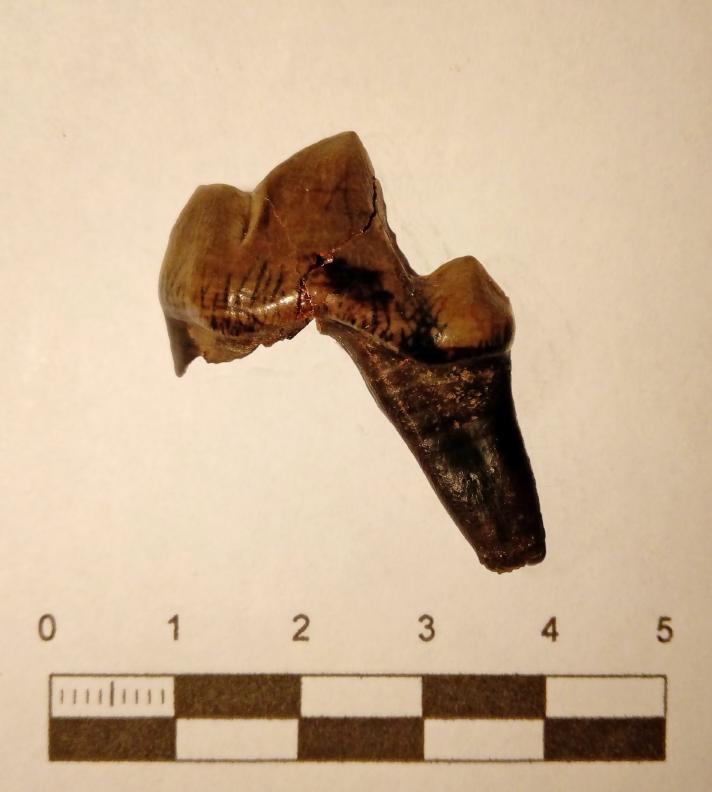| Record number | JS129 |
| Number of items | 1 |
| Related record | JS80 |
| Note | same animal |
| Identification | |
| Simple name | fossil |
| Full name | wild dog carnassial tooth |
| Other name | wild dog (juvenile) |
| Named collection | Xenocyon |
| Classified name | Mammalia & Carnivora & Canidae & Xenocyon lycaonoides |
| System | Linnaean |
| Status | verified |
| Note3 | compared with Xenocyon from Westbury at Natural History Museum, London |
| Currency | |
| Authority3 | Parfitt, Simon, Dr (Natural History Museum) |
| Authority | |
| Brief description | Fossil, wild dog (Canis (Xenocyon) lycaonoides) carnassial tooth (lower left m1); in situ find from the early Middle Pleistocene deposits, Cromer Forest-bed Formation (Runton Member, West Runton Freshwater Bed, junction of bed d and bed f) of West Runton beach, 8m east of rhino skull site; 267 m east of West Runton datum, West Runton, Norfolk, UK |
| Note | The tooth is only lightly in wear, so likely to be a juvenile. The state of wear is similar to JS80 and probably the same individual. |
| Description | |
| Form | carnassial (lower left m1) |
| Field collection | |
| Place | & & West Runton & Norfolk & UK |
| Site name | West Runton beach |
| Note4 | 8m east of rhino skull site; 267 m east of West Runton datum; 6 metres from the toothrow JS80 |
| Locality number | |
| Coordinates | geocoordinates : 52°56'25.87"N, 1°15'18.84"E |
| Relative position | |
| Stratigraphy | rock : Cromer Forest-bed Formation & Runton Member & West Runton Freshwater Bed & junction of bed d and bed f |
| Stratigraphy | stage : Cromerian |
| Stratigraphy | age : Pleistocene & early Middle Pleistocene |
| Stratigraphy | |
| Note4 | |
| Note3 | |
| Method | in situ find |
| Person | collector : Stewart, Jonathan |
| Date | 11.2017 |
| Collection number | |
| Permanent location | |
| Recorder | MRW : 15.11.2017 |
| Description | |
| Completeness | |
| Condition | |
| Part:dimen:reading | : : |
| Part:aspect:desc | |
| Conservation | |
| Method | |
| Person | conservator : |
| Date | |
| Note | |
| Reference number | |
| Photography | |
| Method | |
| Person | photographer : Warren, Martin |
| Date | 5.6.2017 |
| Photograph number | WP_20160605_028.jpg |
| Photograph number | WP_20160605_024.jpg |
| Photograph number | WP_20160605_022.jpg |
 JS129_1.jpg |
|
| Type3 | digitised image |
| Process | |
| Type | |
| Method | |
| Person | : |
| Date | |
| Note | |
| Reference number | |
| Documentation group | |
| Link | jswestrunton.html |
| Documentation group | |
| Link | |
| Class | |
| Reference | |
| Reference number | |
| Admin category | importance : 1 |
| Note | A new species for Norfolk and Cromer Forest-bed. The second record for the British Isles (after Westbury sub Mendip). Most northerly fossil record to date. |
| Notes | In differentiation of these remains from other large canids the following dimensions show clearly that this specimen, identified as Xenocyon differs from Canis lupus (wolf, from Barnwell Cave, Somerset or Oreston Cave, Plymouth) and Cani s dirus (dire wolf). |
| Note | JS Xenocyon lacaonoides : m1 length = 29 mm; width = 20 mm ratio = 1.45 |
| Note | JS Xenocyon lacaonoides : M1 (carnassial) length = 28.5 mm; ration m1/m1 = 0.98 |
| Note | X. lycaonoides from Bed 3, Westbury sub Mendip (NHM : M33965) left m1 length = 26 mm (approximately) |
| Note | Canis lupus (Hutton and Barnwell Cave or Oreston Cave, Plymouth) : M1 length = 7.5 mm; width 9 mm ratio = 0.835 |
| Note | Canis lupus m1:M1 = 0.835 |
| Note | Canis dirus : l/w ratio = 1.125 |
| Note | Canis lupus : m1:M1 = 1.50 |
|
|
|